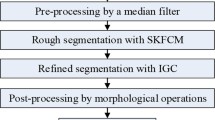Abstract
In this paper, kidney lesion segmentation in MRI using clustering with salp swarm algorithm (SSA) is proposed. The segmentation results of kidney MRI are degraded by the noise and intensity inhomogeneities (IIHs) in MR images. Therefore, at the outset, the MR images are denoised using median filter. Then IIHs are corrected using the max filter-based method. A hard-clustering technique using SSA is developed to segment the MR images. Finally, the lesions are extracted from the segmented MR images. The proposed method is compared with the K-means algorithm using well-known clustering validity measure DB-index. The experimental results demonstrate that the proposed method performs better than the K-means algorithm in the segmentation of kidney lesions in MRI.
Access this chapter
Tax calculation will be finalised at checkout
Purchases are for personal use only
Similar content being viewed by others
References
Luyckx VA, Tonelli M, Stanifer JW (2018) The global burden of kidney disease and the sustainable development goals. Bull World Health Organ 96:414–422D. https://doi.org/10.2471/BLT.17.206441
Cova MA, Cavallaro M, Martingano P, Ukmar M (2011) Magnetic resonance imaging of the kidney. In: Quaia E (ed) Radiological imaging of the kidney. Medical radiology. Springer, Berlin, Heidelberg. https://doi.org/10.1007/978-3-540-87597-0_6
Martlin-Fernlandez M, Alberola-Llopez C (2005) An approach for contour detection of human kidneys from ultrasound images using Markov random fields and active contours. Med Image Anal 9:1–23
Li L, Ross P, Kruusmaa M, Zheng X (2011) A comparative study of ultrasound image segmentation algorithms for segmenting kidney tumors. In: Proceedings of the 4th international symposium on applied sciences in biomedical and communication technologies. Article no 126, pp 1–5. https://doi.org/10.1145/2093698.2093824
Kim D-Y, Park J-W (2004) Computer-aided detection of kidney tumor on abdominal computed tomography scans. Acta Radiol 45(7):791–795
Skalski A, Jakubowski J, Drewniak T (2016) Kidney tumor segmentation and detection on computed tomography data. In: IEEE international conference on imaging systems and techniques (IST), Chania, Greece
Yang G, Li G, Pan T, Kong Y, Wu J, Shu H, Luo L, Dillenseger J-L, Coatrieux J-L, Tang L, Zhu X (2018) Automatic segmentation of kidney and renal tumor in CT images based on pyramid pooling and gradually enhanced feature modules. In: 24th international conference on pattern recognition (ICPR), Beijing, China. IEEE, pp 3790–3795. https://doi.org/10.1109/ICPR.2018.8545143
Choudhari K, Sharma R, Halarnkar P (2020) Kidney and tumor segmentation using U-Net deep learning model. In: 5th international conference on next generation computing technologies (NGCT-2019). https://doi.org/10.2139/ssrn.3527410
Pang S, Du A, Orgun MA, Yu Z, Wang Y, Wang Y, Liu G (2020) CTumorGAN: a unified framework for automatic computed tomography tumor segmentation. Eur J Nucl Med Mol Imaging. https://doi.org/10.1007/s00259-020-04781-3
Kaur R, Junejaa M, Mandal AK (2019) Computer-aided diagnosis of renal lesions in CT images: a comprehensive survey and future prospects. Comput Electr Eng 77:423–434
Nikken JJ, Krestin GP (2007) MRI of the kidney—state of the art. Eur Radiol 17:2780–2793. https://doi.org/10.1007/s00330-007-0701-3
Li S, Zöllnera FG, Merrema AD, Peng Y, Roervikc J, Lundervoldd A, Schada LR (2012) Wavelet-based segmentation of renal compartments in DCE-MRI of human kidney: initial results in patients and healthy volunteers. Comput Med Imaging Graph 36:108–118
Rudra AK, Chowdhury AS, Elnakib A, Khalifa F, Soliman A, Beache G, El-Baz A (2013) Kidney segmentation using graph cuts and pixel connectivity. Pattern Recogn Lett 34:1470–1475
Yang X, Minh HL, (Tim) Cheng K-T, Sung KH, Liu W (2016) Renal compartment segmentation in DCE-MRI images. Med Image Anal 32:269–280
Rusinek H, Lim JC, Wake N, Seah J, Botterill E, Farquharson S, Mikheev A, Lim RP (2015) A semi-automated “blanket” method for renal segmentation from non-contrast T1-weighted MR images. Magn Reson Mater Phys Biol Med 29:197–206
Will S, Martirosian P, Würslin C, Schick F (2014) Automated segmentation and volumetric analysis of renal cortex, medulla, and pelvis based on non-contrast enhanced T1- and T2-weighted MR images. Magn Reson Mater Phys Biol Med 27:445–454
Akin O, Elnajjar P, Heller M, Jarosz R, Erickson BJ, Kirk S, Filippini J (2016) Radiology data from The Cancer Genome Atlas Kidney Renal Clear Cell Carcinoma [TCGA-KIRC] collection. The Cancer Imaging Archive. https://doi.org/10.7937/K9/TCIA.2016.V6PBVTDR
Clark K, Vendt B, Smith K, Freymann J, Kirby J, Koppel P, Moore S, Phillips S, Maffitt D, Pringle M, Tarbox L, Prior F (2013) The Cancer Imaging Archive (TCIA): maintaining and operating a public information repository. J Digit Imaging 26(6):1045–1057
Mohana J, Krishnavenib V, Guo Y (2014) A survey on the magnetic resonance image denoising methods. Biomed Signal Process Control 9:56–69
Balafar MA, Ramli AR, Mashohor S (2010) A new method for MR grayscale inhomogeneity correction. Artif Intell Rev 34:195–204
Mirjalili S, Gandomi AH, Mirjalili SZ, Saremi S, Faris H, Mirjalili SM (2017) Salp Swarm Algorithm: a bio-inspired optimizer for engineering design problems. Adv Eng Softw 114:163–191
Davies DL, Bouldin DW (1979) A cluster separation measure. IEEE Trans Pattern Anal Mach Intell 1(2):224–227
Si T, De A, Bhattacharjee AK (2014) Brain MRI segmentation for tumor detection using Grammatical Swarm based clustering algorithm. In: Proceedings of IEEE international conference on circuits, power and computing technologies (ICCPCT-2014), Nagercoil, India, 2014
Si T, De A, Bhattacharjee AK (2015) Grammatical swarm based segmentation methodology for lesion segmentation in brain MRI. Int J Comput Appl 121(4):1–8
Si T, De A, Bhattacharjee AK (2016) MRI brain lesion segmentation using generalized opposition-based glowworm swarm optimization. Int J Wavelets Multiresolution Inf Process 14(5):1650041 (29 pp)
Derrac J, Garcla S, Molina D, Herrera F (2011) A practical tutorial on the use of nonparametric statistical tests as a methodology for comparing evolutionary and swarm intelligence algorithms. Swarm Evol Comput 1:3–18
Author information
Authors and Affiliations
Corresponding author
Editor information
Editors and Affiliations
Rights and permissions
Copyright information
© 2021 The Author(s), under exclusive license to Springer Nature Singapore Pte Ltd.
About this paper
Cite this paper
Si, T. (2021). Kidney Lesion Segmentation in MRI Using Clustering with Salp Swarm Algorithm. In: Gao, XZ., Kumar, R., Srivastava, S., Soni, B.P. (eds) Applications of Artificial Intelligence in Engineering. Algorithms for Intelligent Systems. Springer, Singapore. https://doi.org/10.1007/978-981-33-4604-8_7
Download citation
DOI: https://doi.org/10.1007/978-981-33-4604-8_7
Published:
Publisher Name: Springer, Singapore
Print ISBN: 978-981-33-4603-1
Online ISBN: 978-981-33-4604-8
eBook Packages: Intelligent Technologies and RoboticsIntelligent Technologies and Robotics (R0)




